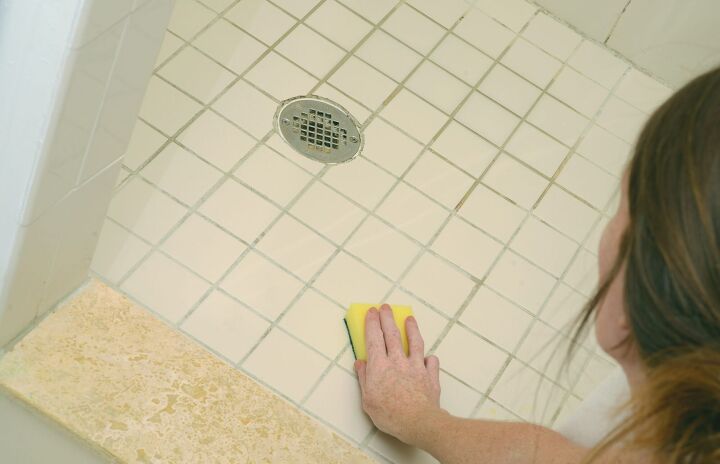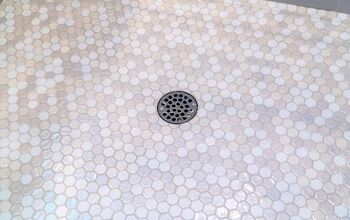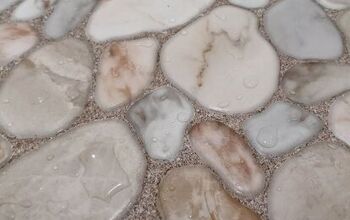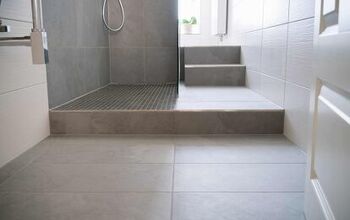How To Clean A Shower Floor

You use your shower to get clean, so if any part of it’s gross, it feels icky instead of relaxing, and you say, “eww” more than “aah.”. If the shower floor starts to get scummy or grimy, it boosts the ick factor because you feel like you’re standing in filth. So what’s the best way to clean the shower floor so you’re not cringing while you’re washing up?
Use nonabrasive cleaners on your shower floor, such as dish soap, liquid laundry detergent, or commercial shower cleaners. For tough stains, try baking soda, vinegar, or hydrogen peroxide. Use a soft sponge, cloth, or brush to clean a fiberglass shower floor. If working with tough grout stains, use a stiff bristle brush. Rinse the floor and let it dry thoroughly.
If your shower floor is looking a bit rough or you simply want a few easy tips to keep it clean, then keep reading. It only takes a little time and effort to make your shower the inviting space you need it to be.
What’s The Easiest Way To Clean Shower Floors?
Of course, routine cleaning is the best way to keep your shower floors sparkling. The more often you clean your shower, the less time soap scum and other unpleasantries have to build up on surfaces.
But when it’s time to clean, what’s the easiest way to clean shower floors so you’re not huffing and puffing? You can find plenty of nonabrasive shower cleaners on the market specifically designed to tackle the common stains and gunk on your shower floor. But you don’t have to limit yourself to commercial shower cleaners.
The key is to use nonabrasive products, including dish soap, liquid laundry detergent, or a gentle all-purpose cleaner. Likewise, use nonabrasive cleaning tools, such as a soft cloth or sponge. Apply a few drops of your cleaner of choice and gently scrub the floors, rinse, and allow to dry.
How Do I Get Tough Stains Off Fiberglass Shower Floors?
What if it’s been a while since you’ve given your shower floor a good scrubbing? Or maybe you’re facing some particularly tough stains. When this happens, a routine clean may not cut it, and you’ll have to try something extra.
You can use a few household products to conquer brown shower floors and other tough stains.
- Baking Soda — Create a paste with a small amount of water and baking soda and apply it to soap scum and other stains. Let the paste sit for a few hours, then gently rub with a nonabrasive sponge, rinse, and let dry.
- White Vinegar — Vinegar is a good option for soap scum, grime, and hard water or calcium deposits in the shower. Pour the vinegar onto your shower floor’s trouble spots and let it sit for a few minutes. Scrub the area with a nonabrasive brush or sponge, rinse, then let dry.
- Hydrogen Peroxide — Certain stains might respond well to hydrogen peroxide but don’t pour the peroxide directly onto the shower floor. Instead, cover the stain with a white cloth, then saturate the cloth with the peroxide. Allow the cloth to sit on the stain overnight, then rinse and dry thoroughly.
- Bleach — Although not a favorite choice because of its fumes, sometimes bleach is your best method for tackling stubborn mildew stains. Apply a small amount of bleach to the stain, let it sit for a few minutes, then rinse. Make sure to wear protective gear, including a mask, eye coverings, and gloves. Do not apply bleach if you’ve recently cleaned the shower with peroxide or vinegar. Mixing bleach with vinegar and other products can create toxic fumes.
What Do You Use To Clean A Tile Shower Floor?
If you have a tile shower floor, you have the added joy of cleaning grout. Look for commercial cleaning products designed for tiled showers. Many of these products clean the surfaces and grout without any need for scrubbing. Follow the directions on the label to ensure you use the cleaner properly.
You can also use white vinegar to clean tile floors. Mix two parts water with one part vinegar in a spray bottle and apply the solution to the shower floor. Use a stiff brush to work the solution into the grout. (Many people swear by repurposing their old toothbrush, but you might find your toothbrush isn’t strong enough for the job.)
After working the vinegar solution into the grout, rinse it and dry it with a towel. Make sure to rinse the floor thoroughly so dirty water doesn’t remain on the grout.
You can also use a baking soda and water paste on grout to work through tough stains. Apply the paste, then spray with your vinegar solution (enjoy the fizzing). After the fizz show, scrub the paste into the grout, rinse thoroughly, and dry. Be careful not to scrub any caulking so you don’t damage it or cause it to lift up in spots.
Tips For Maintaining A Clean Shower Floor
Once your shower floor is spotless, keep it that way with these easy tips.
1. Clean Your Shower Weekly
Regular cleaning is the best way to maintain a clean shower floor. It also makes the job go so much easier and faster. Aim to clean the shower once a week using your cleaning method of choice.
2. Tackle Shower Stains Right Away
Stains are always easier to clean when they haven’t had a chance to hang around for a while. Therefore, clean stains as soon as possible.
3. Apply A Grout Sealer
To help prevent yucky buildup on grout, apply a grout sealer every one to two years. The sealer can help prevent scummy buildup and make your floor easier to clean.
4. Rinse The Shower Floor After Every Shower
When you’re finished showering, rinse the shower floor completely to help get rid of any remaining soapy residue. This quick and easy step can significantly help limit the amount of soap scum that builds up on your shower floor.
5. Restore Fiberglass Shower Floors With Automotive Polish
Yep, you read that right. Is your fiberglass shower floor looking a bit worse for wear? Give it some new life with automotive polish. The product helps eliminate scratches and brighten up dull spots, leaving your shower floor looking like new.
6. Keep Your Shower Dry To Keep It Clean
To help prevent mildew and mold, make sure to properly ventilate your bathroom following every shower. If applicable, turn on your bathroom exhaust fan during your shower.
If you don’t have a fan, open a window to create air circulation and let steam and moisture out of the space. It’s important to help eliminate as much moisture from the air as possible to avoid mildew growth.
If you have shower doors, leave them open following your shower to promote proper airflow. It also wouldn’t hurt to give the shower floor and walls a quick wipe down with a towel to speed up the drying process. (This last step is especially helpful if you don’t have adequate ventilation in your bathroom.)
Getting Squeaky Clean In The Shower
If you want to feel clean after your shower, you need to start with a clean shower floor. Routine cleaning and proper ventilation after showering are key to creating a clean shower space. Use commercial shower cleaners, or try dish soap or laundry detergent. No matter what cleaner you choose, ensure you only use nonabrasive products on a fiberglass shower floor.
Baking soda, vinegar, and hydrogen peroxide are all good options to tackle tough stains. For extra stubborn mildew spots, you might need to use chlorine bleach. If you do, wear proper safety equipment and don’t mix the bleach with other cleaners.
With regular maintenance, you can keep your shower floor sparkling and inviting. Because who wants to go “eww” when they step into their shower?
Related Guides:

Stacy Randall is a wife, mother, and freelance writer from NOLA that has always had a love for DIY projects, home organization, and making spaces beautiful. Together with her husband, she has been spending the last several years lovingly renovating her grandparent's former home, making it their own and learning a lot about life along the way.
More by Stacy Randall




















![How To Reset A Whirlpool Cabrio Washer [In 5 Easy Steps!]](https://cdn-fastly.upgradedhome.com/media/2023/07/31/9076531/how-to-reset-a-whirlpool-cabrio-washer-in-5-easy-steps.jpg?size=350x220)






